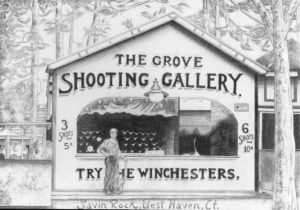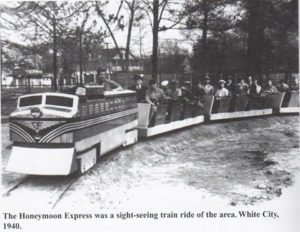
Remembering Savin Rock
Part III
In 1900, Frank Wilcox, another pioneer in shore amusement, purchased Skeele’s and enlarged it to accommodate 1000 diners. His fifty-and-seventy-five cent dinners became famous up and down the New England coast. It was here that the first automatic doors, with photoelectric sensors were introduced, in 1931.
By 1902-1903, the White City emerged on the former site of the old Connecticut League baseball park; incandescent lighting drew nighttime crowds, and from then on, Savin Rock became like a miniature Coney Island. Fireworks and balloon ascents were featured, and band concerts filled the night air with their wonderful sounds.
Alas, in 1917 and 1918, two fires did over $100,000 in damage to Savin Rock’s buildings and amusements. In 1921, four more fires destroyed various Savin Rock icons. Throughout the decades, fires would level many of the Savin Rock attractions. However, by 1922, Liberty Pier had been added, complete with novelty and refreshment stands, fun houses, and a new roller coaster called “The Devil”. In 1932, this pier was itself destroyed in yet another colossal fire.
 Since this was the era of the Great Depression, it might be reasonable to think that the Savin Rock fathers would have abandoned further development; but such was not the case. By 1938, a new skating rink was in place, as was a new fun house and a water-scooter was built in the grove. The un-named Hurricane of 1938 wrecked almost all of the buildings on the ocean side of Savin Rock; the only building spared, was the Showboat, which was ironically the only building covered by hurricane insurance.
Since this was the era of the Great Depression, it might be reasonable to think that the Savin Rock fathers would have abandoned further development; but such was not the case. By 1938, a new skating rink was in place, as was a new fun house and a water-scooter was built in the grove. The un-named Hurricane of 1938 wrecked almost all of the buildings on the ocean side of Savin Rock; the only building spared, was the Showboat, which was ironically the only building covered by hurricane insurance.
After the close of World War II, it became apparent that Savin Rock was slipping. In appearance, it was becoming more and more seedy. The buildings were slowly disintegrating; sidewalks were cracked and buckling. Parking was becoming a problem, and dozens of buses were arriving each weekend from New York and New Jersey, to an area without sufficient sanitary facilities to serve their needs. Litter and blight became apparent throughout the area. Clearly, the end was near.
Still, in the 1950s, Savin Rock visitors consumed over a million hot dogs a year, along with weekly consumption of 6700 lobster rolls, 300 gallons of clams and 800 pounds of shrimp, washed down by 360,000 bottles of soda pop—all of this coming from a place known throughout surrounding states as “Hot Dog Alley”.
In winter, Savin Rock revelers could still pick up a split hot dog or an order of fried clams to bring home; take-out orders were passed over-the-counter and through a small sliding door in the glass between the grill man and the customer. Such foods sustained Savin Rock devotees in the off-season, as they awaited the return of summer.
But over-the-counter food sales were eventually banned in Savin Rock. And, on September 12, 1963, the hard-fought urban renewal project began–it ultimately swept away the old Savin Rock–the amusement park ceased to operate in 1966. Today, it is remembered through the Savin Rock Museum, located next door to Jimmies.
Sadly, the children of today will never realize the joys and pleasures that they missed, for today, no trace of the Savin Rock amusement park exists, except in the fond and lingering memories of those children who are long since passed their childhoods.
Looking for information and or pictures of my grandfather’s milk stand. It was a refrigerated cow with white and brown udders. You could get plain or chocolate milk and ice cream
My grandfather was Philip Kolemenski(Cole)
Thank you
Betty Buddington.